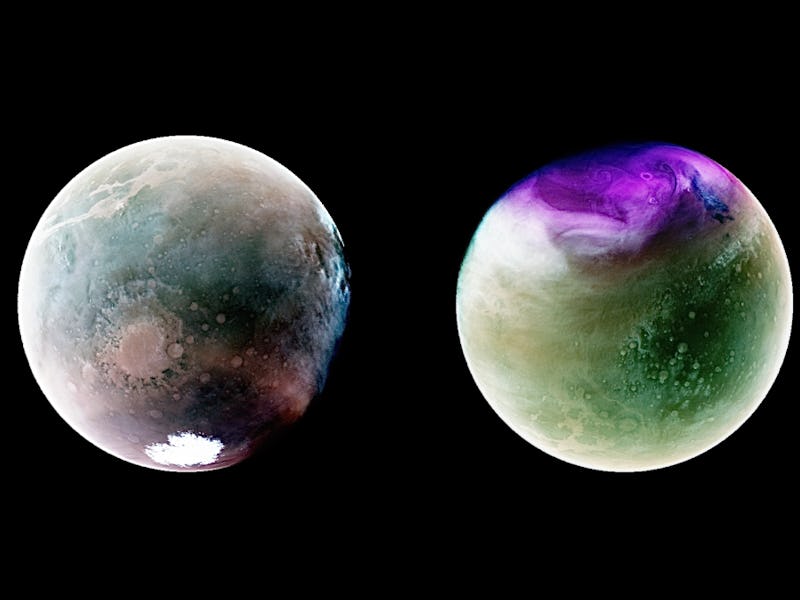Stunning New NASA Images Show Mars Like You've Never Seen It Before
Ultraviolet images from NASA's MAVEN spacecraft shed light on how Mars's atmosphere escapes into space and what it may have been like in the distant past.

Don’t worry, Mars’ northern hemisphere isn’t collapsing; that’s just an optical illusion in the latest images from NASA’s Mars Atmosphere and Volatile EvolutioN (MAVEN) spacecraft.
The latest pair of images from MAVEN shows Mars in a weird new light — ultraviolet, to be precise. Studying the planet’s upper atmosphere and understanding how so much of it has been lost to space during the last few billion years can help scientists reconstruct the planet’s past: a time when Mars was warmer, wetter, and had a thicker, more breathable atmosphere. MAVEN captured this pair of images six months apart, offering a snapshot of how the seasons change Mars’ atmosphere.
NASA released this pair of images on June 22, 2023. The first image was taken in July 2022, and the second is from January 2023.
Hazy Martian Summer Days
In this image, the Martian southern polar ice cap stands out in stark white against the rest of the planet in shades of tan and green.
The first image offers a look at summer on the southern half of Mars. At this point in the Martian year, the planet is making its closest pass to the Sun (about 126 million miles), and its axis is tilted to point the southern hemisphere toward the Sun.
As the image shows, summer haze gets trapped in deep craters like Argyre Basin, which shows up in pinkish-light brown in the lower left of this image. Clouds also cling to the deep canyons of Valles Marineris, the jagged light tan shapes in the upper left of the image. Warm, rising air carries water vapor high into the thin Martian atmosphere during the summer months, where it’s vulnerable to being stripped away by solar wind and radiation.
“Understanding atmospheric loss gives scientists insight into the history of Mars’ atmosphere and climate, liquid water, and planetary habitability,” says NASA’s Willow Reed, communications lead for MAVEN, in a statement.
Springtime on Mars
This false-color image shows Mars’ northern hemisphere during early spring.
Six months later, Maven took a second image, this time showing the northern half of the planet during Martian springtime. Valles Marineris is in the lower-left corner of the image this time. The swirling shades of purple at the top of the image represent ozone in the planet’s upper atmosphere; Mars’s north pole looks oddly concave thanks to an optical illusion that makes the darker shades look farther away, or deeper into the planet.
During the dark, frigid northern winter, ozone collects near the Martian north pole, where there’s less sunlight to break apart the molecules. Every spring, rising warm air lifts the water vapor that had settled in the planet’s lower atmosphere; the water molecules start to react with the ozone molecules waiting at higher altitudes. Those chemical reactions break down the ozone, and the yearly cycle begins again.
Because our eyes can’t see ultraviolet light (unlike butterflies, reindeer, and some birds), the team that turned MAVEN’s raw data into images had to match visible colors to different wavelengths of ultraviolet light. Greens and tans show the Martian surface, clouds appear white, and ozone shows up in shades of purple and magenta.
MAVEN is wrapping up its tenth year in orbit around Mars, and NASA says the spacecraft has enough fuel to last until 2030. In addition to studying the Martian atmosphere, the satellite also acts as a communications relay for the Perseverance Rover.
This article was originally published on